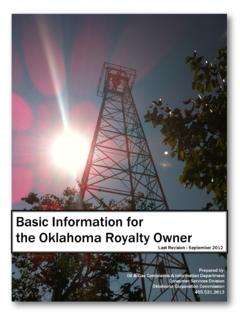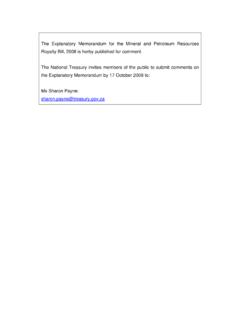Transcription of Addback: It’s Payback Time - barnwellco.com
1 addback : It s Payback Timeby Charles F. Barnwell, 2000, 18 states have enacted addback rulesto curb perceived taxpayer abuses based on the useof interest and intangible-related expenses betweenrelated parties. Generally, those antiabuse statutesrequire the payer of related-party interest, royalties,license fees, and similar charges to add back thoseexpenses. Every state has some exceptions to therequired addback , and those exceptions are dis-cussed in detail in this , the states failed to act uniformlyand the rules have significant differences. Thosedifferences are often subtle and can result in confu-sion and conflicts from state to state.
2 The addbackrules seem to have the following in common: most require the operating company to addback intercompany interest and expenses re-garding intangibles paid to a related party; most states define a related party by referenceto the Internal Revenue Code (discussed indetail below); all states have exceptions to the addback rule,and in most cases the exceptions exist to mini-mize the likelihood of multiple taxation; most states provide an exception to addbackbased on the recipient s tax position (the subject-to exceptions); most states have a conduit exception (that is,interest or royalty is ultimately paid to a thirdparty); and most states tax both direct and indirect interestand intangible items among related a practical matter, the addback laws in NewYork, Massachusetts, Michigan, Ohio, and Oregonare less relevant because of their adoptions of grossreceipts or unitary tax systems.
3 Tennessee does notrequire addback unless the taxpayer fails to discloserelated-party transactions. Thus, there are 13 states(including the District of Columbia) where taxpay-ers face the confusion and sometimes multiple in-come tax burden brought on by the addback article delves into the sometimes subtle butimportant distinctions and issues confronting tax-payers in the addback states. The states havecreated several ambiguities and have set the stagefor multiple taxation, particularly for taxpayers thatfail to anticipate traps and plan against addback rules appear to raise facial constitu-tional issues, and taxpayers will certainly bringthose issues to court over the next few years.
4 Thisarticle focuses on the practical issues, such as therequired disclosures, how to calculate exceptions,and how to avoid the How Did It Come to This?Before dissecting the addback provisions, onemust understand the historical background, or why18 states have pushed those rules through their leg-islatures since court decisions in the early1990s set the stage. The first wasGeoffrey, a seminalSouth Carolina Supreme Court af-terGeoffrey, the Georgia Superior Court drew a sec-ond line in the sand inAaron becamea widely cited victory for the states, whileAaronRentsbecame a widely cited victory for the cases dealt with similar fact patterns,the tax theory behind them was very different.
5 TheSouth Carolina Tax Commission asserted the newand novel5doctrine of economic nexus as it related1 Refer to Exhibit 1 (p. 000) for a state-by-state comparisonof the addback rule characteristics and , Mississippi, North Carolina, and Ohio appearto be the first offenders, having enacted addback rules in2000 and 2001 (see Exhibit 1).3 Geoffrey, Inc. v. South Carolina Tax Commission, Respond-ent, 437 SE2d 13 313 SC 15, July 6, Rents, Inc. v. Marcus E. Collins., Civil Action FileD-96025, Georgia Superior Court Fulton County, June 27,1994. (For the decision, see94 STN 132-18.)5 New and novel at least at that F. Barnwell, Jr.
6 Is president of Barnwell & in Atlanta. The firm, founded in 2000, specializes instate and local taxation. He has more than 20 years of stateand local tax experience, the first 15 of which were spent inBig Four public accounting. Admitted as a partner withKPMG in 1991, he was instrumental in establishing thefirm s national state tax minimization author acknowledges his partners R. BruceJacobson, David L. Mallory, and Michael Mimbs fortheir contributions to this article. The firm s Web site Tax Notes, November 17, 20081to intangibles; that is, the commission sought to di-rectly tax an intangible holding company located contrast, Georgia sought to disallowAaron s royalty payments to its wholly owned sub-sidiary, also located in addback rules appear to raisefacial constitutional issues, andtaxpayers will certainly bring thoseissues to court over the next those two cases deal with markedlydifferent theories, they have important practicalsimilarities.
7 Both fact patterns involved relativelynew Delaware intangible holding companies, inter-company royalties, and reductions in state incometaxes. During the 1990s companies such AaronRents and Toys R Us began to isolate intangibleassets in holding companies in identical fact pat-terns. Other companies used different states andalternative intercompany tax base shifts. Althoughthe motivations for those actions were purported tobe for business reasons,7companies generallyachieved a reduction in separate state income taxliabilities as a result of the intangible holding com-pany , retailers, manufacturers, and other tax-payers with valuable intangible assets, capitalizingonAaron Rentsand arguing againstGeoffrey, recog-nized the business reasons for isolating intangiblesand the serendipitous opportunity to reduce statetaxes.
8 Holding companies became common, as evi-denced by the myriad court decisions that arose inthe years that followed8 and as further evidencedby the extent of new addback , although it was merely a Georgia trial courtdecision, was often cited and discussed at state taxpractitioner forums and presumably became a de-fense of sorts for many companies that sought tocombat state audit challenges. Many states usedGeoffreyto justify directly taxing intangible holdingcompanies. Companies continued to develop plan-ning structures that used intangibles, and statescontinued to refine the arguments to challenge planners also recognized the opportunity tositus intangible assets in companies with predomi-nate apportionment footprints in unitary approach had several advantages over thevanilla Delaware or Nevada holding company struc-ture.
9 First, the unitary company typically had sub-stantial operations within the same entity thatowned valuable intangibles. Second, it provided fac-tor relief in instances in which the offended statesought to tax the owner of the intangibles (as op-posed to the alternative, orAaron Rents, approach ofdisallowing the intercompany royalty). In manycases, companies with headquarters in unitarystates had a natural ability to situs intangibles inthe headquarters state without the need (or risks) ofcreating a tax haven planners developed other variations on theplanning theme, such as double passive investmentcompanies. Still other companies without the advan-tage of unitary state parentage would create aunitary dominant company with some separate fil-ing state leakage.
10 For example, in some cases, evenif headquarters existed in a separate filing state, theunitary state-based factors would so dilute the com-pany s separate filing state apportionment factorthat the planning remained many cases, companies withheadquarters in unitary states hada natural ability to situs intangiblesin the headquarters state withoutthe need (or risks) of creating a taxhaven controversy characterized the state incometax landscape, in which taxpayers sometimes won,sometimes lost. Unfortunately, in many cases thetaxpayer ended up paying tax twice on an eco-nomic nexus claim on the intangible holding com-pany, and on a disallowance, combination, or othertax on the operating company.






